By Laura Coltofean-Arizancu, Postdoctoral Researcher.
As our days in Siberia were full and we generally worked every day from morning to evening, we did not have much time for leisure. Our free time was usually in the evenings, after dinner, when we took the opportunity to talk with our families and friends (if the internet connection was good enough to allow this), while sometimes enjoying a Russian ice cream. Thinking back, I realize that going to supermarkets was also a way of relaxing and having fun for us in the Altai, although I’m quite sure we didn’t acknowledge this while we were there. When out for shopping, we would spend at least an hour wandering among the shelves and staring with amusement at unknown, colourfully packaged Russian products with descriptions we could not understand. We also often ended up buying more food than we actually needed. Writing this post, I now realize that the supermarket and shopping were means of compensating for our isolation and the limited possibilities in terms of food and activities. In a country where everything was quite different to what we knew, the supermarket was one of the few places and concepts that were familiar to us, in the sense that they were similar to those we have at home. It is interesting to note how a generally ordinary experience, such as shopping in the supermarket, can become an extraordinary experience in a different geographical, cultural and social context.
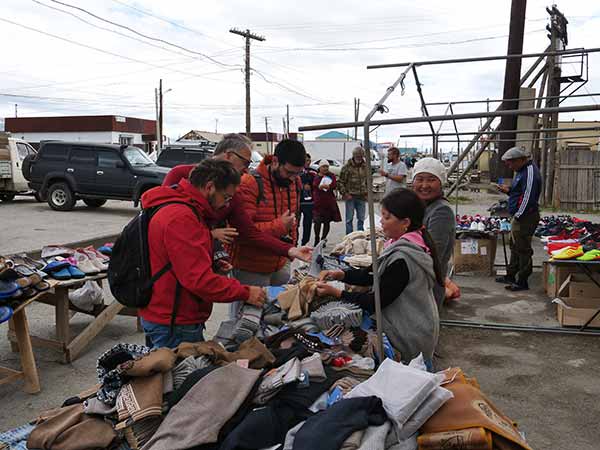
Shopping in Kosh-Agach
16 August was our only free day during the expedition. Vasiliy and Leonid drove us to Kosh-Agach, a village 50 km from the Mongolian border, which is the driest inhabited place in the Russian Federation. It has less than 150 mm average rainfall a year, as we found out while browsing Lonely Planet in the car. On our day there, though, it miraculously rained. Kosch-Agach, however, seemed to be so grey and desolate, that it looked like the end of the world to us. As we did not have many options, we visited a market that resembled a miniature shopping mall. We wandered through its corridors, as we did in the supermarkets, while curiously looking inside the tiny shops, most of which sold clothes. We observed that the clothing options for women were much more varied than those for men, which were predominantly army style. We then understood why men in the Altai commonly wear military-style clothing. It was sort of a trend. In front of the market there was a strategically situated stand where a mother and her daughter sold cashmere, yak and camel wool clothing from Mongolia. This stand was so well placed, and the small family so pleasant, that you could not resist stopping and engaging in conversation with the vendors. Soon, we all ended up buying something: warm socks, trousers, scarves and caps. We later realized that these were winter clothes and since most of us live in the warm Mediterranean area, we did not really need them, but, as I explained before, shopping was our compulsive pleasure amid such isolation.
After having lunch in Kosh-Agach, Vasiliy took us to a place where we had an awesome view across the dramatic snowy peaks of the North-Chuysky mountain range. The beauty of the landscape and its heavy silence which was only disturbed by tourists’ cars, were simply terrific. You could just stand there endlessly and stare, feeling that as individuals we are so small and our problems are so insignificant! We took loads of photos to capture that memorable panorama. Vasiliy knows the area very well and he knew exactly where to take us and what to show us. Although he goes on photographic tours in this area several times a year, I clearly saw that he was still deeply moved by what was before his eyes. Throughout our expedition I was constantly impressed by his love for and strong connection with the Altai Mountains. On our way back to Beliy Bom, we also stopped at the Geyser Lake, which has a unique, turquoise colour and does not freeze in winter. Looking at the lake, from time to time we could see different oval and round shapes appearing on its bottom, drawn by the erupting underwater geyser. Our experience that day was so incredible, that once back in the cars we simply sat in silence and admired the sunset.
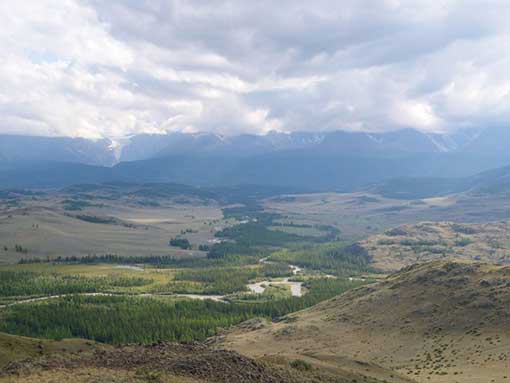
The snowy peaks of the North-Chuysky mountain range.
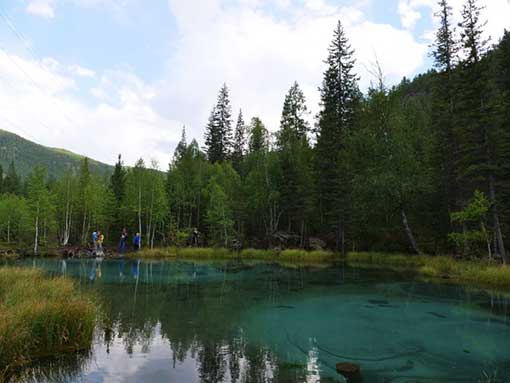
View over the Geyser Lake.
Besides fieldwork, food was our main concern during the expedition. I often tried to externalize myself to observe our behaviour. It was interesting to note how in such simple living conditions our attention was much more focused on food than at home. And it is not that we did not have food. Oh, there was plenty of it! And it was delicious! Our options were, however, more limited. Besides being a rock art specialist, Elena is also an excellent cook. She prepared breakfast and dinner for us almost daily. In the mornings we usually had omelettes with vegetables and/or sausages, mint cookies, biscuits, jam, condensed milk (my favourite!), as well as coffee and, of course, chai (tea). In the evenings, Elena made soups, omelettes, potatoes with vegetables and salads for us. We usually had lunch in the so-called “kaffe”-s, which, despite their name, are not coffee shops, but restaurants. During our expedition we tried several such restaurants. The kaffe next to our accommodation in Beliy Bom was run by an Altaic family and it was very simple, but it served the best food we ate in the Altai. It was there that we were introduced to typical Turkic and Russian dishes such as manti (dumplings) with different fillings, among which the most extravagant (for us) was horse meat, hricka and rice with vegetables, yak meat, pancakes with potatoes, lapioshka (bread), as well as soups such as the famous borscht, okroshka and rassolnik, and so on.
We also enjoyed drinking juices such as kompot and mors, both prepared from fruit. Some of the restaurants also included Western and Southern European dishes on their menus, especially from Italian cuisine. However, all the pizza, pasta and tiramisu that we tried were complete disasters. This led our proud Italian team members, Tommaso and Adriano, to decide to cook pasta and show us how real Italian pasta should taste. They bought pasta, tomatoes and tuna fish, the only products they could find, and cooked a delicious pasta al tonno with 100% Russian ingredients. All of us were very pleased with the result and Elena learned a new recipe that, as she told us after the expedition, she even tried after we left. One of the highlights of our expedition, in terms of food, was our first jar of Nutella. It was deliberately displayed on a special, more visible shelf of a small shop, as the royal product among more everyday items. Tommaso spotted it and bought it for the equivalent of 6 euros and a bit, which was quite expensive compared to the prices in our supermarkets. This Nutella brought us a lot of (unexplainable) happiness, and we thoroughly enjoyed it on the following mornings with biscuits, coffee and tea.
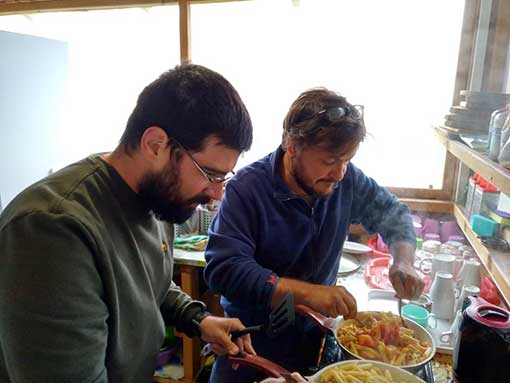
Adriano and Tommaso cooking pasta.
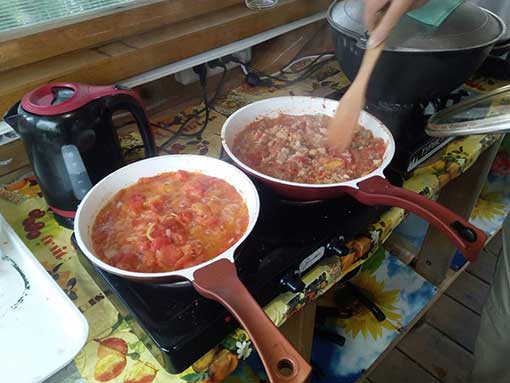
Pasta al tonno with 100% Russian ingredients
For most of us the stay in Siberia was the first time we had lived and worked together in the field for such a long time. We had the previous experience of Ulldecona, but this time it was different as we were strangers in an unknown place. We therefore had to rely on each other more than usual. It was interesting for me to observe how in those conditions we unconsciously realized that it was not wise to act as individuals anymore, but rather collectively, as group. It wasn’t me or Marga or Tommaso anymore, it was us, the Artsoundscapes team. A team in which of course each member had their own particularities, but a team that nevertheless performed as a whole. In the Altai Mountains we had to harmonize all the differences between us, learn to live together and reach (at least temporarily) a collective sense of team and scientific family. We had our good moments and
some that were not quite so good, but on the whole it was a great experience and I personally now feel closer to each team member. I think we are now more adapted to each other and are able to communicate more easily. I believe that each of us played their particular role in the expedition and it certainly would not have been the same if one of us had not been there.
For the last three days of the expedition we were on the road again. On the morning of 24 August we packed our luggage and went from Chemal to Gorno-Altaysk. We took our last group photo with Elena, Leonid and Vasiliy near our hotel and then said our farewells. When they left, I felt as if it were one of the times they were just going shopping for food. This time, however, they did not come back. We spent our afternoon in Gorno-Altaysk without them, visiting the main square with Lenin’s statue and shopping for Russian sweets for our families and friends. In the evening, some of us watched Emir Kusturica’s ‘Black Cat, White Cat’, while others worked. Next morning, we went to the airport and said our goodbyes to Andrzej, who was to stay in the Altai until the end of September working on his own research.
We left Gorno-Altaysk at 10 am and when we arrived in Moscow it was still 10 am! The confusion arising from the change in time zones lasted throughout the day. We were very tired and must have looked like disoriented persons wandering in the desert. We had planned to visit the famous Red Square, but we were so hungry (again!) that we first wanted to have lunch. When we finished and were finally heading towards Red Square, we found out it had been closed for a military parade just a few minutes earlier, while we, of course, were eating. With all the main tourist attractions closed, we started wandering around the shopping mall where we had previously eaten and then in the city. Our visit to Moscow slowly turned into a culinary and consumerist tour with our main stops including an ice cream shop, a Starbucks and a fancy restaurant. The city was an explosion of colours, shapes and sounds. As Tommaso put it very well, in the Altai we got used to only seeing three colours: the green of the grass, the blue of the sky and the grey of the rocks. In Moscow, everything seemed so varied compared to the Altai. At one point, standing on a bridge over the Moskva River and staring at the skyscrapers on the horizon as if we had never seen such buildings before, Tommaso said “we’re like humble peasants from the mountains”. We laughed. He was right.
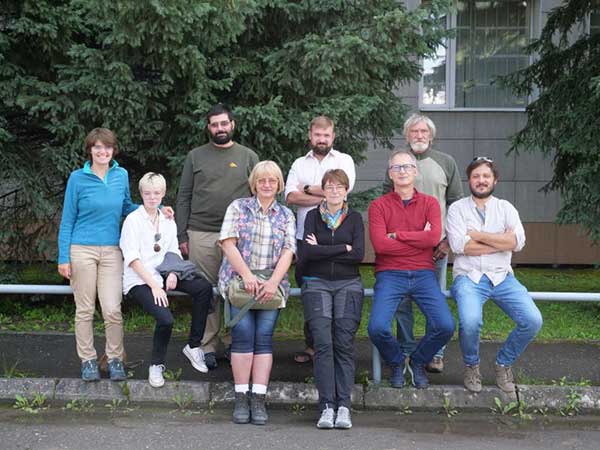
Our last photo in Gorno-Altaysk
We returned to Barcelona on 26 August. We did not have much time to rest, nor to reflect on our stay in Siberia, as we immediately had to start preparing for the 25th Annual Meeting of the European Association of Archaeologists in Bern (Switzerland) from 4 to 7 September. As a whole, the Siberian expedition was an enriching experience for all of us, both scientifically and personally. For me it was certainly a dream come true, as I had wanted to travel to Siberia since I was a child. It was also a spiritual exercise, a great opportunity for introspection and, as I said in my previous post about Siberia, a lesson in modesty, simplicity and inclusiveness. This expedition has also touched the limits of each of us to some extent and thus helped us grow in many ways that we might not yet realize. We have definitely learned a lot, not only about Siberia and rock art in the Altai, but also about ourselves as individuals and as a group.
